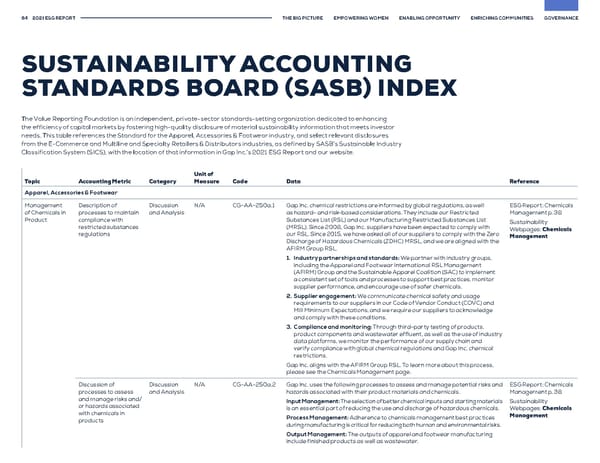64 2021 ESG REPORT THE BIG PICTURE EMPOWERING WOMEN ENABLING OPPORTUNITY ENRICHING COMMUNITIES GOVERNANCE SUSTAINABILITY ACCOUNTING STANDARDS BOARD (SASB) INDEX The Value Reporting Foundation is an independent, private-sector standards-setting organization dedicated to enhancing the efficiency of capital markets by fostering high-quality disclosure of material sustainability information that meets investor needs. This table references the Standard for the Apparel, Accessories & Footwear industry, and select relevant disclosures from the E-Commerce and Multiline and Specialty Retailers & Distributors industries, as defined by SASB’s Sustainable Industry Classification System (SICS), with the location of that information in Gap Inc.’s 2021 ESG Report and our website. Unit of Topic Accounting Metric Category Measure Code Data Reference Apparel, Accessories & Footwear Management Description of Discussion N/A CG-AA-250a.1 Gap Inc. chemical restrictions are informed by global regulations, as well ESG Report: Chemicals of Chemicals in processes to maintain and Analysis as hazard- and risk-based considerations. They include our Restricted Management p. 38 Product compliance with Substances List (RSL) and our Manufacturing Restricted Substances List Sustainability restricted substances (MRSL). Since 2008, Gap Inc. suppliers have been expected to comply with Webpages: Chemicals regulations our RSL. Since 2015, we have asked all of our suppliers to comply with the Zero Management Discharge of Hazardous Chemicals (ZDHC) MRSL, and we are aligned with the AFIRM Group RSL. 1. Industry partnerships and standards: We partner with industry groups, including the Apparel and Footwear International RSL Management (AFIRM) Group and the Sustainable Apparel Coalition (SAC) to implement a consistent set of tools and processes to support best practices, monitor supplier performance, and encourage use of safer chemicals. 2. Supplier engagement: We communicate chemical safety and usage requirements to our suppliers in our Code of Vendor Conduct (COVC) and Mill Minimum Expectations, and we require our suppliers to acknowledge and comply with these conditions. 3. Compliance and monitoring: Through third-party testing of products, product components and wastewater effluent, as well as the use of industry data platforms, we monitor the performance of our supply chain and verify compliance with global chemical regulations and Gap Inc. chemical restrictions. Gap Inc. aligns with the AFIRM Group RSL. To learn more about this process, please see the Chemicals Management page. Discussion of Discussion N/A CG-AA-250a.2 Gap Inc. uses the following processes to assess and manage potential risks and ESG Report: Chemicals processes to assess and Analysis hazards associated with their product materials and chemicals. Management p. 38 and manage risks and/ Input Management: The selection of better chemical inputs and starting materials Sustainability or hazards associated is an essential part of reducing the use and discharge of hazardous chemicals. Webpages: Chemicals with chemicals in Process Management: Adherence to chemicals management best practices Management products during manufacturing is critical for reducing both human and environmental risks. Output Management: The outputs of apparel and footwear manufacturing include finished products as well as wastewater.
 GAP ESG Report Page 63 Page 65
GAP ESG Report Page 63 Page 65